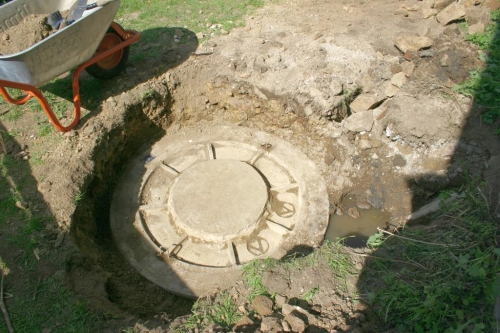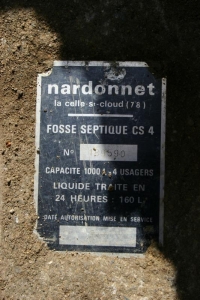When we first visited the farm, we couldn’t help but notice that there was no conventional toilet. We wondered whether the occupants were evangelical environmentalists, who insisted on using an earth closet for high-minded reasons. However, not wanting ourselves to “Sprinkle a layer of earth after every use”, we asked about the septic tank whose existence the estate agent had claimed. “Oh yes,” we were assured, “there is a septic tank, but we don’t know where it is.”
Bravely (or foolishly) we didn’t let this put us off. And it came to pass that we moved in, to find a bare pipe where presumably a toilet had once sat. And a bathroom sink which drained into a bucket, rather than the adjacent disconnected drain pipe. Undaunted, we unpacked the toilet which we had purchased and brought with us. It was quickly connected to the drain, and I poured a bucket of water tentatively into the bowl. Nothing much happened, and there was a similar lack of drama when I followed it with several more buckets. Success, we thought. And this was confirmed when we found that the sink also drained smoothly when it was actually connected to the waste pipe.
And for nearly a year, our optimistic assumption proved sustainable. The toilet flushed, the sink drained, the washing machine rinsed. Yes the shower was sometimes rather slow to drain, but we treated this as just a harmless idiosyncrasy. All the water was leaving the house, and so what if we had no idea where it was going?
We were visited by a woman who had grown up in the house, and who was visiting the area for some sort of reunion. I asked (rather to her surprise) whether she remembered where the septic tank was placed when her parents had the extension built in the 1970s. Somewhere round the back of the house was her best guess, but she would ask her brother if he knew any more precisely. Of course, we heard no more. But who cared, because the water was leaving the house . . . .
Until a month or so ago, when it became clear that the water was proving to be rather reluctant to make its departure. The shower water pooled around our feet, until dispersed with a plunger. The sink gurgled noisily when emptied. And, most alarmingly, when the toilet was flushed, there were strange rumblings and sucking noises from both sink and shower.
Clearly, a blockage was developing in the drainage system, probably in the whereabouts-unknown septic tank.
A brief technical diversion is appropriate here, while you hold your breath (figuratively for you, literally for us) for the next stage in the drama. Our waste doesn’t go into a sealed tank which stops working when it is full. Such a tank, which has to be emptied every time it fills up, is called a cesspit (“fosse étanche”). A septic tank (“fosse septique”) is a holding tank, through which the waste water flows. It’s always full of liquid, and each time water enters the tank an equal amount leaves. The outflow runs along pipes to a filter system, sometimes of sand or, if the soil is suitable, just of earth. We had tried to locate this outflow, by looking in the fields for a particularly green patch in the dryness of last summer – but with no luck.
The role of the septic tank in the drainage system is to allow the solid matter (yes, use your imagination, and keep holding your breath) to be acted on by bacteria. All of this delightful material is decomposed over time, leading to a biological equilibrium. Which is why you mustn’t put bleach down a toilet connected to a septic tank, because it kills the bacteria which are eating the shit (different type of imagination needed!).
Unfortunately, no good things last for ever, and inevitably over time the digested remnants of solids, along with anything inappropriate put down the toilet, will accumulate until the system starts to block up. At that point, the tank has to be emptied and cleaned, before re-filling with water and starting again. Current rules say that this should be done every four years.
Obviously, the rules were different in the 1970s, or they wouldn’t have hidden the tank unmarked under the ground. How exactly do you empty a tank that you can’t find? When was it last emptied? Is it ever going to work again?
Logic suggested that all other questions could wait until we could find the tank. There seemed to be three ways of approaching this – we could start from the house, work back from the outflow, or use some method to directly detect the tank. As we hadn’t been able to find the outflow, and our divining skills are undeveloped, I decided to start by digging a trench to look for where the waste left the house.
Most of the soil on our land is soft and easily dug. Unfortunately, the house is built on a great slab of sandstone, and the soil near the house is full of rocks – in fact it’s more rock than soil. Digging in this was hard work, and progress was slow. As I had no idea how deep the pipework might be, I didn’t know how deep to dig the trench. After several metres of trench along the back of the bathroom, I was tiring and beginning to despair. I left it for a couple of days, hoping for more energy and inspiration.
Val suggested that I should make one last effort with this trench, going towards the house. And this proved to be the inspiration, because suddenly I struck gold. Well, actually what happened was that a stream of very smelly liquid started to seep into the trench. Fearing that this would be like one of those old films where drilling for oil leads to a huge spray rising into the air, I backed away sharply.
Luckily, this was much less dramatic. A puddle of dark nastiness collected at the bottom of the hole, and lay there gently yet ominously shimmering.
Further, nose-closed excavation revealed a concrete pipe sloping gently at a diagonal away from the house. More now rather smelly rock removal ensued, and eventually I hit smooth concrete. Could this be the holy grail I sought? Gradually a curve emerged. And then a thin line running away at a right angle. And then another smaller circle. It seemed we had found something wheel-shaped. It had to be the mysterious septic tank!
After much further labour, with Val valiantly wheelbarrowing away loads of stone and earth, and we could stand back to consider the revealed edifice:
It was the tank! And on one edge, still in excellent condition after some 35 years underground, was the maker’s plaque. A 1000 litre tank, judged sufficient at the time for four people. Times have moved on, and the minimum size to meet current standards is 3000 litres. Perhaps the biggest surprise is that this small tank has taken so long to actually become clogged up!
Armed with the knowledge of the location and dimensions of the tank, we can fix for someone to come to empty and clean it. Under the handy Yellow Pages category of ‘Vidange et curage’ (‘Emptying and Cleaning Out’) we find the promising Monsieur Gaume who offers a website and email contact!
So, all has been arranged. On Friday morning, at 09h00, M Gaume is scheduled to arrive and relieve us of our smelly burden. We hope to be left with a sparkly clean and fully functioning sewage system. Although I can’t actually see how he will get the lid off the tank, I have faith. And anyway, we now have a chemical toilet brought back from England. So even though it is now raining too much to make outside toileting comfortable, we can wait patiently for all to be revealed on Friday.









Cheers Si! Was just about to eat dinner when I read this little gem… My appetite lessened somewhat! 🙂 Glad all your efforts proved fruitful – let’s hope all goes well with the cleaner man!
Is it done???
We went looking for ours the other day as the farmer has used the bales on top of where it allegedly was! First found a trickle of smelly water – luckily from the cow byre – found our tank lid lower down where local knowledge said it would be!! Now have to decide when it needs cleaning.